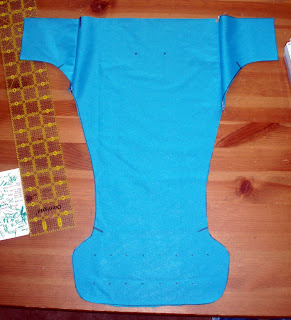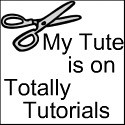This leads to a lot of waste. And especially with something like PUL, I hate to have all these large but not quite large enough fabric scraps going to waste. So sometimes I piece the PUL together to get a piece larger enough to make a diaper. Here's how I do it.
Stuff you need.

Your pattern, a ruler, a washable marker (I'm using black so it will show up in the pictures; normally I'd go with something closer to the colour of the fabric), and your PUL.

This particular piece of PUL is wide enough for a newborn or small diaper, but not wide enough for what I need, which is a large diaper.
 I start by laying the pattern on the fabric. In this case I am going to piece the wings, so I'm placing it as close to the edge as I can while still leaving a seam allowance (you can see I forgot the seam allowance and started to trace, then changed my mind and moved the piece over a half an inch or so).
I start by laying the pattern on the fabric. In this case I am going to piece the wings, so I'm placing it as close to the edge as I can while still leaving a seam allowance (you can see I forgot the seam allowance and started to trace, then changed my mind and moved the piece over a half an inch or so).
Here I am using the ruler to figure out where to cut off the wings on this side - I don't actually need to piece this wing, but I like the final result to be symmetrical. Normally I am working with fabric pieces that are a lot narrower than this one, too. I place the ruler about a half inch out from the edge of the narrower part of the diaper and mark this line both on the pattern piece and on the fabric.
 Here is the traced pattern piece. I've marked both the seamline and added a half inch seam allowance, as well as transferring all pattern markings (snap and elastic placement).
Here is the traced pattern piece. I've marked both the seamline and added a half inch seam allowance, as well as transferring all pattern markings (snap and elastic placement).
The pattern piece cut out, with bonus small child elbow.
 Here you can see the PUL piece laid over the pattern, with the seamline marked on both.
Here you can see the PUL piece laid over the pattern, with the seamline marked on both. Another shot showing the seamline on the other side. Now that I have these marked on the pattern piece I can get out more scrap pieces and trace out more diapers whenever I need to. I like to label it 'seam' so that I'm perfectly clear that that's the actual seam, not the seam allowance.
Another shot showing the seamline on the other side. Now that I have these marked on the pattern piece I can get out more scrap pieces and trace out more diapers whenever I need to. I like to label it 'seam' so that I'm perfectly clear that that's the actual seam, not the seam allowance.OK, set aside that piece of PUL. Now we need to cut out the wings.
Lay the pattern piece onto a scrap of PUL and trace around the wing, marking the seamline and anything else important, like the elastic placement mark.


 Use the ruler to draw on the seamline. Remember, this is the seamline, so when you cut the piece out make sure to leave a seam allowance.
Use the ruler to draw on the seamline. Remember, this is the seamline, so when you cut the piece out make sure to leave a seam allowance. Repeat for the other side - make sure to use the other side of the pattern! Ask me how often I wind up with two identical pieces for the right wing and no piece at all for the left wing. Let's just say it happens a lot.
Repeat for the other side - make sure to use the other side of the pattern! Ask me how often I wind up with two identical pieces for the right wing and no piece at all for the left wing. Let's just say it happens a lot.
Next I like to lay the pieces out to make sure everything is right. Looks good!
 Put the PUL right sides (dull sides) together, matching up the seam lines, and sew using polyester thread. Now, my machine HATES sewing shiny PUL, so I actually have to add a layer of tissue paper on top of this so it'll feed through the machine. A walking foot or a teflon foot are supposed to be helpful, but I don't have either of those. So tissue paper it is! Sometimes a coffee filter if I can't find tissue paper. Hey, whatever works.
Put the PUL right sides (dull sides) together, matching up the seam lines, and sew using polyester thread. Now, my machine HATES sewing shiny PUL, so I actually have to add a layer of tissue paper on top of this so it'll feed through the machine. A walking foot or a teflon foot are supposed to be helpful, but I don't have either of those. So tissue paper it is! Sometimes a coffee filter if I can't find tissue paper. Hey, whatever works.Sew both wings in place, then check your work.

I have had bad experiences ironing PUL in the past, so a lot of the time I don't bother. Or I'll put the iron on the lowest setting and only iron on the dull side, never on the laminated shiney side. Although that doesn't seem to actually flatten out the seam at all. So mostly I just skip ironing. I only make pieced diapers for my own baby, and she doesn't seem to mind the lack of ironing. Although who knows, perhaps her first words will be 'yo, mom, you too damn lazy to iron? what's up with that?'.
I mean, it's either going to be that or 'cat', I suspect.
Ahem.
The final piece, ready to be turned into a diaper:

Now, I have terrible luck with PUL leaking at seams, although theoretically a run through a hot dryer should seal the holes. So I like to add a sort of facing to the back of the piece to cover up the seams and keep moisture from getting anywhere near them. This is what I mean:
 Basically I cut out another piece of PUL so that it will cover the seams and baste it into place (shiny side facing up), then make the diaper. The PUL used for this bit doesn't even have to match, since it'll be hidden inside the diaper. Other people online claim they never have leak problems with seamed PUL, so this is optional. I have lots of scrap PUL to use up, so it works for me!
Basically I cut out another piece of PUL so that it will cover the seams and baste it into place (shiny side facing up), then make the diaper. The PUL used for this bit doesn't even have to match, since it'll be hidden inside the diaper. Other people online claim they never have leak problems with seamed PUL, so this is optional. I have lots of scrap PUL to use up, so it works for me!I haven't actually put together the diaper yet, but I'll add a pic of the finished one when I get to it.







1 comment:
Thanks for that tutorial!
Post a Comment